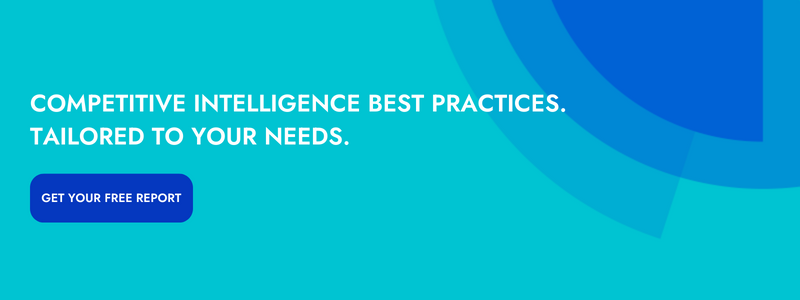The foundational goals of a competitive intelligence program are to enable the organization to better understand their market, make stronger strategic decisions, and ultimately increase revenue. But, what exactly does that mean for someone who wants to get started with competitive intelligence? How do you build a competitive intelligence process?
The unfortunate truth is that not everyone is well versed in the process of competitive intelligence. The State of Competitive Intelligence Report dug into how different teams conduct their competitive intelligence process. This report is the largest study of best practices and challenges within the competitive intelligence industry. Covering everything from goals, KPIs, and resources - we realized that a lot of companies have a different approach to the competitive intelligence process.
To help you get started, we’ve outlined this six step process to design a competitive intelligence process. Let’s take a look at the six easy steps to designing an effective competitive intelligence process, and the benefits for your whole organization.
1. Identify Your Competitors
The first step in the competitive intelligence process is to identify your competitors. Have a robust competitive landscape? Start with your top five direct competitors. In addition to your direct competitors, you should identify your indirect competitors, your aspirational competitors, and your perceived competitors. Your indirect competitors are key players within your industry but likely don’t compete with you for customers. Your aspirational competitors are those leading companies within your industry that you don’t necessarily compete with, but you can pull inspiration from to benefit your own business. Finally, your perceived competitors are those companies that may come up during the sales discovery process, but that you don’t actually compete with for business. If you want to segment your competitive landscape even more, you can break it down by sales vertical or industry focus, and solution type. Identifying your competitors is key to beginning your competitive analysis and diving deeper into your market to understand your competitive landscape.
NEED COMPETITIVE INTELLIGENCE BEST PRACTICES? USE OUR FREE TOOL >>
2. Identify Areas of Interest to Track in Your Competitors’ Digital Footprints
Once you’ve identified your competitors, and who you want to start analyzing, you should choose major focus areas for the data you need to collect. Consider all of the data accessible online about each of your competitors as well as internal knowledge from your front-line teams. If you narrow down the types of intel you care most about, data points that align with current initiatives, it will be easier to digest the data. If you’re unsure where to start, try exploring some of the most engaging competitive intelligence types.
3. Gather Your Intel
The act of gathering the intel can be the most time-consuming step of the competitive intelligence process. In fact, The State of Competitive Intelligence reported that 36% of time dedicated to CI/MI goes toward the research phase. This is where you have to take the time to explore your competitors’ online presence and gather information about their products, websites, teams, announcements, social media engagements, content, and everything in between. You want to gather the most intel about each of your competitors so that you can dig in and analyze the data to pull out the valuable insights.
4. Create a Competitive Analysis
Analyzing the intel is where your analyst or competitive intelligence manager breaks down the data, pulls out the key trends and essential pieces of information, and organizes the findings so that it can be easily communicated throughout your organization. Creating a competitor analysis can be done a couple different ways. One way is to do a benchmark or baseline analysis, which will allow you to compile your data and create a competitor profile.
Competitor profiles or battlecards are highly useful to ensure that your findings on each competitor are being kept within one centralized document. An equally important approach to a competitor analysis is to analyze competitive intelligence on an ongoing basis, in real-time. It’s beneficial to create profiles on your competitors, but it’s even more valuable to continue to track your competitors. The best way to keep a pulse on your competitors is by setting up alerts on everything from new news mentions to product changes to customer reviews. That way, you can stay on top of your competitors’ moves and continue to arm your team with up-to-date analysis.
5. Communicate Intel
The worst thing to happen when you’ve gathered competitive intelligence is if no one consumes your findings. You want to ensure that the key stakeholders see your findings and that the data is being leveraged to improve your own strategies. The State of Competitive Intelligence report found that 78% of companies share their competitive intel via email, 64% use meetings, and 28% of companies use an internal chat. A useful tool that many people take advantage of for intel communication is Slack (or other internal chat), where they can easily communicate competitive intel to their whole company via instant message. Another great place to store complete competitor profiles if you don’t have a CI platform is on a collaborative website such as a company wiki or intranet. That way, you can alert your coworkers when new intel is added, and you can ensure that the information is in an easy to locate place.
6. Turn Data into Results
So, now you’ve identified your competitors, gathered intel, analyzed the data, and effectively communicated your findings to the relevant stakeholders. The final step is to make your data actionable - use your findings to benefit your overall business strategy. Here are a few ways you can make the data actionable for each of your key stakeholders.
Benefits for Your Executives
Your executives have a lot on their plates, but they need competitive intelligence insights to effectively steer the organization. While they might not be the ones acting on the insights, they want to have a view of the competitive landscape so they know what their teams are focused on. When you deliver insights to an executive, follow these tips for making sure they’re getting the most out of the data.
Benefits for Your Marketing Team
The information you gathered about your competitors’ marketing efforts, whether that be content marketing, events, social media, messaging, or A/B tests, can be used to improve and implement new marketing initiatives. In collaboration with the product team, your product marketers can craft stronger messaging to assist with upcoming product launches, website copy, and collateral for your whole organization.
Benefits for Your Sales Team
The information you gained about your competitors’ pricing, sales teams, and products can be used to improve your sales collateral, demo scripts, and sales processes. If you turn the information you gathered into sales battlecards or competitor profiles, your sales team will be well equipped with the information needed to turn competitor intelligence into revenue won. The data that you arm your sales team with can give them the competitive edge they need to better handle competitive objections throughout the sales process and win more competitive deals.
Benefits for Your Product Team
Gathering information about your competitors’ products from their websites, customer reviews, and online forums is a great way to improve your own products. Knowing the specs of your competitors’ products, how they work, and what people like (or dislike) about the solutions can help your product team iterate to make your product even better.
There are many tools that you can use to assist with gathering intel and analyzing your competitive landscape. There is a lot of valuable data on the internet about each of your competitors, and with the right resources, you can seamlessly integrate competitive intelligence into your existing business strategy. If you follow these steps, you can pull out key pieces of intel, communicate it to your team, and derive value from the data you gathered during your competitive intelligence process.


